Xi Jinping and Muscatine, Iowa
Swallow Yan / Des Moines, Iowa / Feb.1, 2012
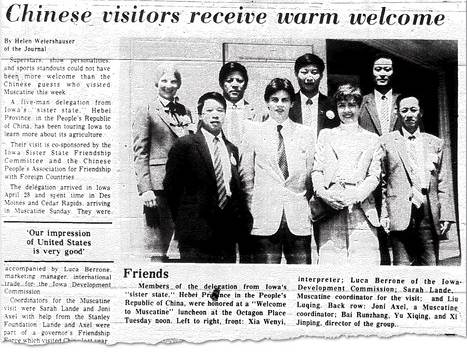
In 1985, then-Zhengding County Party Chief Xi Jinping led a Hebei delegation to Muscatine, Iowa. The Muscatine forks hosted a welcome event at the Octagon Place, also known as Octagon Place of Samuel de Sinnette, in Muscatine, Iowa. The picture shows the 32-years-old Xi Jinping at the rightmost on the second row.
[About the Octagon Place]
This farm house was built in 1855, before the civil war. The architectural style is Italian Villa. There is a lot of interesting what you might call folk lore surrounding this building. The two-story brick home with wrap-around porch and windowed cupola is now used as an office building. On July 18, 1974, it was added to the National Register of Historic Places.
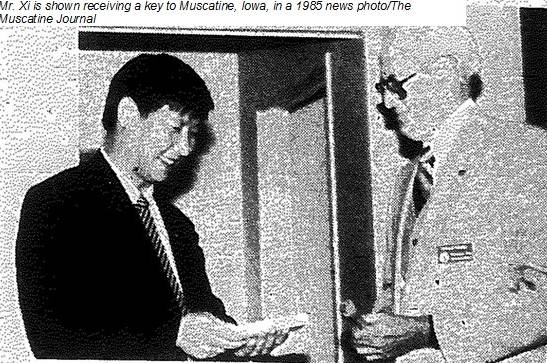
One
of the most interesting story is that this was a station on the underground railroad. (The underground railroad was a string of "safe" houses and other hiding places for staves who ran away from their servitude and needed to get to Canada) When the historical society was taken on a tour of this historic building before it was converted into a restaurant, we were shown a pantry off the kitchen which had a false floor. Under the floor was a space about 7 foot deep and larger enough for a couple of people. The basement walls were built in such a way that this space was undetectable.
This is just one of the tales about this octagon house and its rather eccentric builder.
The Octagon Place, one of 27 octagon houses known in Iowa, is a two-story octagonal brick building in a combination of Italian villa and Greek Revival styles. Samuel de Sinnette (who later dropped the de in his name) immigrated to America from Ireland and in 1840 purchased 320 acres of farmland on the northeast edge of Muscatine. He was determined to build a house that would astound the people living nearby. In 1855, at age 38, Sinnette built the beautiful home and made it the site of much lavish entertaining in its day. He and his wife Sarah reared 7 children.
Samuel designed the home himself from drawings he had made of an old Scottish castle. Local builders were skeptical of Sinnette's plans and shook their heads in disbelief when he insisted the rooms inside have perfectly square walls and comers. He had to import builders from the east coast to show that such a structure could be built.
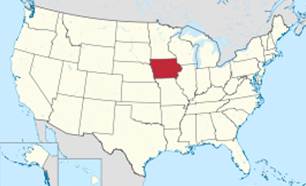 Iowa in U.S.
Iowa in U.S.
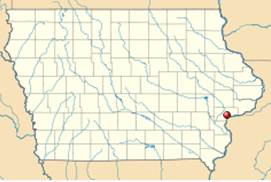 Muscatine in Iowa
Muscatine in Iowa
Octagon Place is usually referred to as having 17 rooms, but it is more accurate to say that the house has 8 rooms, 4 on the first floor and 4 almost identical rooms on the second floor. Adjacent to the 8 rooms are several smaller rooms. There are 6 fireplaces in the home. The 8-sided house offers heating advantages because each of the main rectangular rooms exposes only one wall to the outdoors. One of the advantages of this form of building is that it encloses 20% more floor area than a square plan with an equal length of exterior wall.
The basement contains great timbers, crossbeams, and uprights that measure 10 by 10 inches. A basement triangular room was reached by a hidden trap door and tunnel to the road. Legend has it that the house served as an inn during the Civil War period and that the tunnel was used to smuggle slaves to freedom.
The winding staircase in the center of the house is considered one of the most beautiful in Iowa. The spiral staircase rises to the second story, up to the attic, and then up to the octagonal tower at the pinnacle of the roof. From the tower windows sunlight streams down to the hallway below.
Octagon Place has been listed on the National Register of Historic Places since 1974.
In 1977 Octagon Place was enlarged, renovated, and converted into a restaurant. Additional remodeling was done in 1986 when Octagon Place was transformed into offices for nonprofit organizations. The West wing was added in 1991.
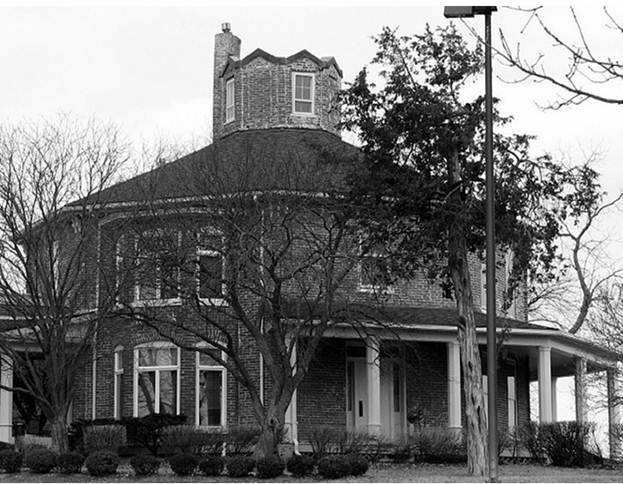 The Octagon Place is located at 2610 Park Ave Muscatine, Iowa
The Octagon Place is located at 2610 Park Ave Muscatine, Iowa
[About Muscatine]
Muscatine is a city in Muscatine County, Iowa, United States. The population was 22,886 in the 2010 census, an increase from 22,697 in the 2000 census. It is the county seat of Muscatine County. The name Muscatine is unusual in that it is not used by any other city in the United States.
Muscatine is the principal city of the Muscatine Micropolitan Statistical Area (2000 census population 53,905), which includes all of Muscatine and Louisa counties.
History
Muscatine in 1865The European-American city of Muscatine began as a trading post founded by representatives of Colonel George Davenport in 1833. Muscatine was incorporated as Bloomington in 1839; the name was changed to reduce mail delivery confusion, as there were several Bloomingtons in the Midwest. Before that, Muscatine had also been known as "Casey's Woodpile".
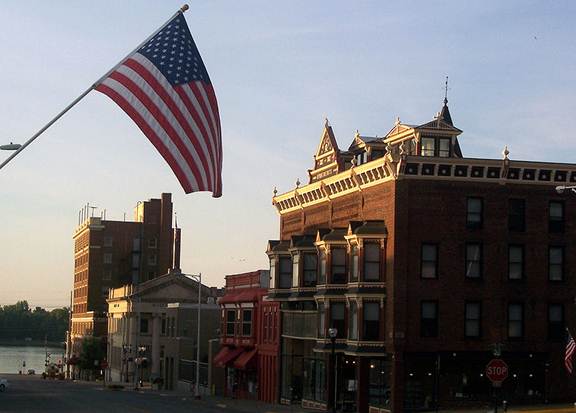
Downtown Muscatine at dawn,looking towards the Mississippi River
The name Muscatine is believed by some to have been named after the Mascouten native American tribe. The Algonquian-speaking Mascoutin were driven out of Michigan in approx 1642 by French and Natives, and they were believed to have been absorbed into the Meskwaki (Fox) and Sac tribes by the early 18th century.In 1819 Muscatine Island was known as Mascoutin Island. An alternative theory is that the name is derived from a Siouan-language term meaning "Fire Island". Major William Williams, who was visiting when the town changed its name in 1849, wrote in his journal: "Muscatine in English is Fire Island," in his list of the meanings of Sioux Indian names.
Williams also wrote a brief description of the settlement:
“ Bloomington is a fine town, one of the most important points in the state. Its situation on one of the great bends of the Mississippi has great commercial advantages; [it] is the seat of justice of Muscatine County. Contains about 2000 inhabitants, is the natural depository for a vast amount of trade from the surrounding country, has many neat residences and several spacious brick mercantile establishments- a large steam mill, one smaller one, two printing establishments, 6 churches, 4 physicians, 8 lawyers, an neat court house and jail, Masonic lodge, etc.... This town is very prettily situated, in part on a level on the river for two streets back, when the ground rises and the remaining street is elevated in benches, the whole standing in a rise enclosed by a range of high bluffs which runs around it in a semicircular form, forming beautiful sites for residences. From the bluff there is a beautiful view of the town below and of the Mississippi for miles up and down. All steam boats land here, passing up and down. ”
—Maj. William Williams
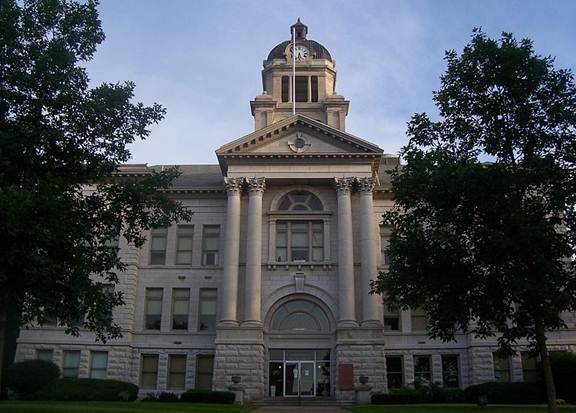
Muscatine County Courthouse
From the 1840s to the Civil War, Muscatine had Iowa's largest black community, consisting of fugitive slaves from the South and free blacks who had migrated from the eastern states. One of the most prominent community leaders was Alexander Clark Sr., a Pennsylvania native, barber and eventually a wealthy timber salesman and real estate speculator. He was among the founders of the local AME Church, assisted fugitive slaves, and petitioned the state government to overturn racist laws before the war. In 1863, Clark helped organize Iowa's black regiment, the 60th United States Colored Infantry (originally known as the 1st Iowa Infantry, African Descent), though an injury prevented him from serving.
In 1868, he successfully desegregated Iowa's public schools by suing the Muscatine board after his daughter Susan was turned away from her neighborhood school. Eleven years later, his son Alexander Jr. became the first black graduate of the University of Iowa College of Law, and its first black graduate from any department. Clark Sr. went to the college and became its second black graduate five years later, despite being 58 years old, saying that he wanted to serve “as an example to young men of his own race.” Clark rose to prominence in the Republican Party, serving as a delegate to various state and national conventions.
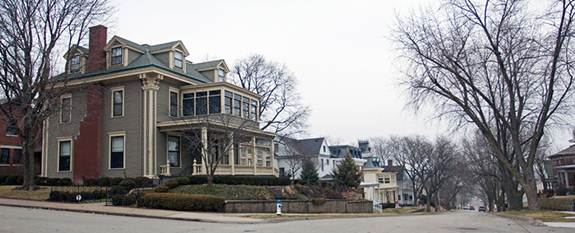
The home of Sarah and Roger Lande, one of the Xi Jinping’s host families in Mascatine in 1985. 15 host families and friends will gather in this house on Feb 15 afternoon to have a a teatime reunion with China VP Xi Jingping.
In 1890, Clark was appointed ambassador to Liberia by President Benjamin Harrison. He was one of four Muscatine residents to be appointed as a diplomatic envoy between 1855 and 1900, a remarkable feat for a town of such small size: George Van Horne was consul at Marseilles, France during the 1860s; Samuel McNutt served at Maracaibo, Venezuela in 1890; and Frank W. Mahin represented his country in Reichenberg, Austria in 1900.

Xi and his delegation received a warm welcome by Mascatine residents in 1985.
Less than a year after arriving in Liberia, Clark died of fever. His body was returned to the US, where he was buried in Muscatine's Greenwood Cemetery. In 1975 the city moved his former house about 200 feet, to make room for a low-income apartment complex for senior citizens; the latter was named in his honor. The University of Iowa's chapter of the Black Law Students Association (BLSA) is named for the Clarks, as a testament to the accomplishments of father and son, and their places in the history of civil rights in Iowa.
The writer Sam Clemens (better known by his pen-name Mark Twain) lived in the city briefly during the summer of 1855 while working at the local newspaper, the Muscatine Journal, which was partly owned by his brother, Orion Clemens. He noted some recollections of Muscatine in his book Life on the Mississippi:
“ And I remember Muscatine—still more pleasantly—for its summer sunsets. I have never seen any, on either side of the ocean, that equaled them. They used the broad smooth river as a canvas, and painted on it every imaginable dream of color, from the mottled daintinesses and delicacies of the opal, all the way up, through cumulative intensities, to blinding purple and crimson conflagrations which were enchanting to the eye, but sharply tried it at the same time. All the Upper Mississippi region has these extraordinary sunsets as a familiar spectacle. It is the true Sunset Land: I am sure no other country can show so good a right to the name. The sunrises are also said to be exceedingly fine. I do not know. ” —Mark Twain

Xi and his delegation visited Monsanto factory in Mascatine in 1985.
The former Hotel Muscatine has recently been remodeled. Opponents to the project
stated the changes would ruin the historical integrity of the building. In 1884 J.F. Boepple, a German immigrant, founded a pearl button company. He produced buttons that looked like pearls by machine-punching them out of clam shells harvested from the Mississippi River. Muscatine's slogan, "Pearl of the Mississippi," refers to the days when pearl button manufacturing by the McKee Button Company was a significant economic contributor. In 1915, Weber & Sons Button Co., Inc. was the world's largest producer of fancy freshwater pearl buttons. From that time forward, Muscatine was known as "The Pearl Button Capital of the World". Weber is still manufacturing today, and celebrated its 100-year anniversary in 2004. Muscatine is nearly as well known as the "Watermelon Capital of the World".

The town and the river of Mississippi.

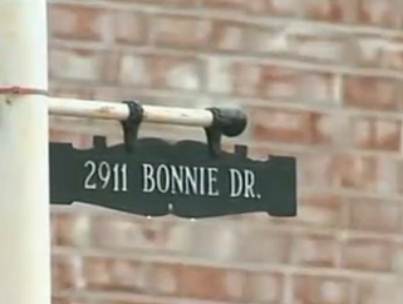
Xi Jinping stayed in the home of Eleanor and Thomas Dvorchak in Mascatine.
 Eleanor Dvorchak and her husband Thomas Dvorchak have moved to Florida but will fly back to meet with Xi Jinping.
Eleanor Dvorchak and her husband Thomas Dvorchak have moved to Florida but will fly back to meet with Xi Jinping.




